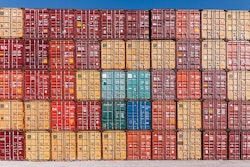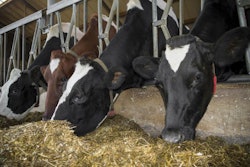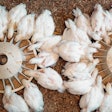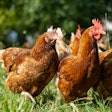
In 2018, 6,000 tons of insects were produced globally across 15 different countries for food and feed; in Europe, roughly 95 percent of this production was black soldier fly and yellow meal worm.
Since July 2017, when the European Union made effective its milestone regulation (No 2017/893) approving use of select insect proteins in aquafeed and pet food, an estimated 1,000 tons of protein derived from insects has been commercialized and used in European aquaculture farms, according to the International Platform of Insects for Food and Feed (IPIFF).
Animal-derived proteins remain prohibited in cow, pig and poultry feed under an EU “feed ban” issued some time ago in response to the bovine spongiform encephalopathy (BSE) outbreak in the late 1990s, although discussions and lobbying are underway to change this.
A 'transitional phase'
While production of insects for feed is clearly on the rise, Christophe Derrien, secretary general of IPIFF, says uptake remains nascent.
Most of the use in aquaculture is on a trial basis, Derrien says, with commercial discussions ongoing.
This is largely because insect production is still very new, without any critical scale, and remains in need of further investment, he says.
“We're still in a transitional phase where the investors need sufficient visibility from downstream to be able to provide all the necessary means for [insect] actors to grow,” Derrien says. Only then will production be able to reach “critical mass” and become relevant on the market, he adds.
To date, EUR350 million to 400 million (US$397 million to 454 million) has been invested in the global insect sector, according to IPIFF, but this figure should soar to EUR2 billion by 2025.
Teun Veldkamp, senior researcher for animal nutrition at Wageningen Livestock Research (WUR) and president of the European Federation of Animal Science (EAAP) Insect Study Commission, suggests that plenty of this funding should be put aside for research.
“For any industry starting out, it's most important to get research results to help with innovation in the sector,” Veldkamp says. His team at Wageningen, for example, is working on several important topics, from substrate conversion by insects and what substrates work best to the effects of nutrient composition and bioactive compounds in insects on growth performance, health and welfare of livestock.
However, he says there remains plenty more to be done.
“I would say we're only at a first level of research; it's really a starting point,” Veldkamp says.
Continued research, he says, will drive successful upscale and empower industry to tackle its biggest hurdle — delivering large volumes at a constant quality.
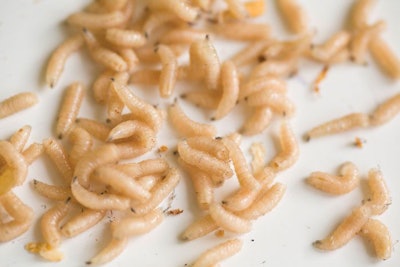
Experts believe a science-driven collaborative push from industry and government might be all that's needed to mainstream insects. | tomazi, iStock.com
Cost-effective insect breeding
Antoine Hubert, co-founder and CEO of Ÿnsect, agrees, but says maintaining cost efficiency is also critical.
“The biggest challenge is to be able to offer competitive solutions to the feed markets, by providing the relevant volumes at a good price, with high quality and high performance,” Hubert says. For Ÿnsect, he says much of this will rely on its ability to scale and optimize farming capabilities and larvae transformation but also diversify end products.
Walter Jansen, CEO and founder of Amusca – a Dutch startup that has designed an automated insect breeding module – believes the future of cost-effective insect production lies in on-site breeding by livestock farmers and feed manufacturers themselves.
“We developed a system where we minimized labor because it's a completely computerized system and we developed a program to control production. So, we have a different approach – we're not going towards a farming approach, we're using a processing approach like when you grow bacteria,” Jansen says.
Amusca's breeding units – the first of which have just been built – can contain six million house flies, three million of which are egg-laying females, and produce 3,500 kilograms of larvae per day. Bred on high-quality vegetable co-product, the on-site larvae can then be directly fed to chickens, along with any substrate remains for additional fiber and minerals, or separated, dried, ground and incorporated into aquafeed.
“There's a lot of opportunity. … I think that when you have the knowledge on how to grow in an economical way – and that point is so important – then the world will be so big,” Jansen says.
Legislative change 'would be helpful'
Tarique Arsiwalla, co-founder and chief operating officer of Protix, believes the fastest way to expand insect production will be through a collective push from numerous worldwide companies.
“More insect producers need to reach the stage where they can supply significant volumes, reliably,” Arsiwalla says. But, he says this will take more than just extra cash.
“Another aspect that would be helpful is further legislative openings to use insects or derivatives thereof, for example allowing the use of processed insect proteins in EU poultry and pork feeds.”
Ian Banks, executive assistant to the CEO at AgriProtein, agrees legislative change will be key to opening up growth avenues.
Banks says EU regulation restricting what can be fed to insects (feed-grade materials only), for example, is blocking AgriProtein's potential business with Europe. The company, headquartered and operating in South Africa, feeds its black soldier flies a variety of organic waste substrates, including restaurant, food factory and farm byproduct.
“Our unique selling point is our ability to handle different waste streams, different feedstock streams, and we've learned a heck of a lot over the last few years on how to take a very varied intake and make it standardized. … We feel that restricting the waste and what can be fed to insects kind of goes against the whole idea of a circular economy. Hopefully, in time, legislation will change,” he says.
Derrien notes that IPIFF is working with its members to push forward a “long-term approach” for insect feed, but suggests short-term efforts should focus on close-to-market substrates like leftover or unsold foodstuff containing meat.
Convincing intermediaries
Rhonda Smith, founder and director of Minerva Communications – a key partner in the 2013-16 EC-funded PROTeINSECT project that evaluated insects as a novel protein source for animal feed – agrees industry needs to focus on substrate innovation but adds the biggest short-term hurdle is acceptance around using insects in animal feed. And not among feed manufacturers, but rather intermediaries like retailers, major farming conglomerates, fast-food restaurants and big distributors.
“These intermediaries, such as the retailers, have a unique position here to be our arbiters of choice. And we're finding, from doing work in this area, that we need to ensure those people in the middle who are making decisions – about whether they'll stock chickens fed on insect proteins or fish fed on a portion of insect protein – will they take the risk?”
“These intermediaries are going to be key. They really need to sign up to this to commit resources, to put their weight behind it, and work in a very collaborative way,” Smith says.


